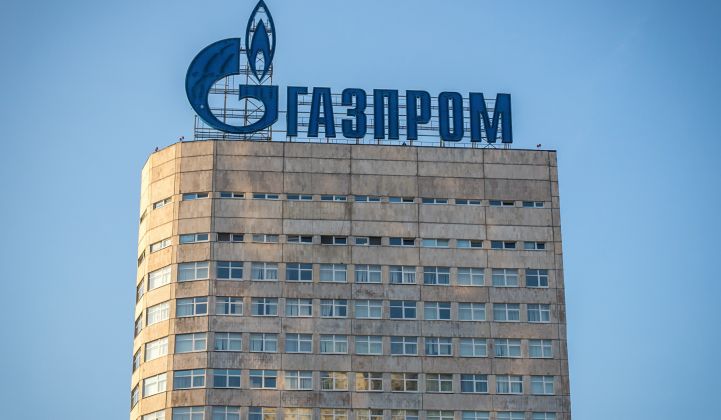In January, Secretary of Defense Jim Mattis called Russia the “principal threat” to America today. But despite Russia's might, there's a glaring chink in its otherwise impenetrable armor: an extraordinary dependence on its sale of fossil fuels.
Over the past decade, the U.S. has developed the ultimate weapon -- clean energy -- to protect us from and neutralize the multi-tentacled Russian threat.
The U.S. clean energy industry, in partnership with the U.S. government, has the opportunity over the coming decades to earn billions while strengthening our national security. Together they can assist Europe in overhauling energy infrastructure and starving Moscow’s budget of its essential fossil fuel revenue, rendering Putin powerless.
Moscow’s dominance of the regional energy market serves as the cornerstone of Europe's vulnerability to the Russian threat. According to RAND, 11 European countries, from Finland to Bulgaria, buy over 90 percent of their vital natural gas from Russia. Germany, our most important ally on the continent, relies on Russia for over 40 percent of all the natural gas it consumes, more than from any other country.
However, this interdependency flows bilaterally. Russia earns over 40 percent of all export revenue from fossil fuel sales to Europe and North America. Moreover, 36 percent of every ruble in the Kremlin’s published budget (USD $85.5 billion) comes directly from these fossil fuel sales.
Putin’s carbon cash-flow addiction constitutes his “critical vulnerability,” essential to feed over 30 percent of the Kremlin’s budget consumed by Russia’s army, security agency FSB, and other security services. Therefore, establishing an “Allied Energy Defense Fund” investing in American-made clean energy in Europe, would accelerate our allies’ drive for energy self-sufficiency, and drain Russia’s financial resources, undercutting its ability to wreak havoc beyond its borders.
Today, to defend America and our allies from the growing Russian threat, the U.S. delivers billions of dollars in security assistance to Europe annually in weapons sales, plus nearly $4 billion in subsidies, direct funding, and expenditures on the continent. Moreover, our NATO allies collectively spend an additional $299 billion on defense.
This money builds bases, trains troops, and buys everything from rifles, tanks and jet fighters to computers and cyberdefense research. We need this defense spending to counter Russian aggression, but to some degree, it merely treats the symptoms rather than delivers the cure.
The U.S. spends over $622 billion worldwide on our own military annually. What if U.S. clean energy partnered with the Pentagon to add 0.5 percent ($3.11 billion), and worked with our NATO allies to do the same ($1.5 billion)?
Together they could subsidize a “buy-American/buy-NATO,” private-sector-driven upgrade of Europe’s energy infrastructure and build a clean-energy smart grid. This Allied Energy Defense Fund would re-catalyze the U.S. clean-energy manufacturing sector to the tune of tens of billions of dollars, with private-sector investment matching government spending at a rate of at least 5 to 1.
But is the prospect of revolutionizing Europe’s energy system logistically, economically or politically realistic?
No doubt it will be more difficult for some countries than others. However, accelerating the integration of Europe’s infrastructure will ease the displacement of Russian energy.
For example, according to data from BP and the European Commission, 44 percent of Latvia’s gas (all of which Latvia imports from Russia) produces 40 percent of Latvia’s total electricity.
A recent report from the British energy consulting firm BVG Associates shows that Latvian wind and solar could produce over double this amount. Or with a new, advanced clean energy grid, Latvia even could just buy Polish wind or German solar electricity (which combined in 2015 produced 10 times more than Latvia consumed).
Moreover, GTM Research shows that electricity from utility-scale solar installations are routinely priced at a few pennies per kilowatt-hour. Average prices for electricity from wind are also just a few cents. This compares to the Department of Energy’s reported 10.34-cent U.S. carbon-fueled average -- rendering renewables the obvious economic choice to displace Russian dirty energy.
Even amid today’s bitterly partisan political environment, this plan can be achieved. America’s clean energy revolution has reached critical mass, and our national security leadership would likely endorse such a concept.
This fund would bring tens of billions in additional private-sector revenue to U.S. clean energy manufacturers, thus creating tens of thousands of new manufacturing jobs in both red and blue districts across the country.
Additionally, since federal dollars only would be used to prime the pump for massive private investment, this initiative could even generate more tax revenue than it expends.
Implementation of such a program will drain the funds Putin needs to threaten or manipulate us and our allies. This fund will make the U.S. and Europe immeasurably safer, without manufacturing a single bullet.
The U.S. clean energy industry stands on the verge of an enormous opportunity worth billions by working with the U.S. government in defense of American security and our allies.
***
Jonathan Morgenstein is founder and CEO of Empowerment Solar, a solar development company in the Middle East, and served two tours in Iraq with the U.S. Marine Corps.



